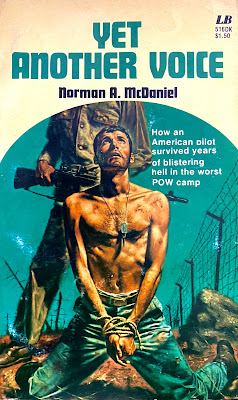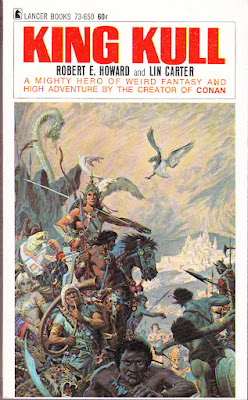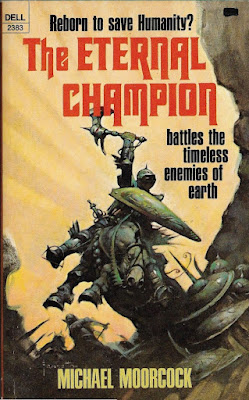Texas author Robert E. Howard (1906-1936) is considered the grandfather of the sword-and-sorcery genre. His most popular and influential character was Conan, an iconic fixture of film, comics, graphic novels, vintage paperbacks, and the pulps. But, Howard's precursor to the famed barbarian was another sword-wielding hero named Kull (or King Kull). In fact, Howard's very first Conan story, “The Phoenix on the Sword”, was a reworking of a Kull story called “By This Axe I Rule!”. Howard authored 12 total manuscripts and a short poem that starred Kull, but only two were published during his lifetime - “The Silent Kingdom” (Weird Tales Aug 1929) and “The Mirrors of Tuzun Thune” (Weird Tales Sep 1929). What happened to the Kull stories after 1929?Let's leap to 1946 and an Arkham House volume called Skullface and Others that featured “The Mirrors of Tuzun Thune”, “The Silent Kingdom”, and the poem “The King and the Oak” (originally published in Weird Tales Feb 1939). Other than this rather limited publication, the Kull stories simply disappeared. In 1966, Glenn Lord, literary agent for the Robert E. Howard estate, located six cartons of the author's papers, including unpublished manuscripts, carbons, and early drafts.* Among these cartons were seven complete, previously unpublished Kull stories, plus three unfinished stories.
Lord then went to work compiling these stories into an omnibus for Lancer, a publisher that was already reprinting Conan stories as paperbacks, including unfinished drafts and stories that were completed by L. Sprague De Camp and Lin Carter. It only made sense for Lancer to do the same thing for Kull that they were doing for Conan. So, the first printing occurred in 1967 as King Kull with gorgeous cover art by Roy Krenkel. The paperback included the 12 Kull stories and the poem, three of which were completed by Lin Carter based on Howard's unfinished manuscripts - “Wizard and Warrior”, “Riders Beyond the Sunrise”, and “Black Abyss”. Minor edits were also made to other stories by both Carter and Lord.** Carter also drew out a handy map of King Kull's World for inclusion.
Ultimately, this King Kull paperback is essential for any sword-and-sorcery, Conan, or Robert E. Howard fan. I really enjoyed the entire collection, but here are three of my favorites:
“The Shadow Kingdom” - Ka-nu is a Pictish ambassador, peaceful to Kull's kingdom of Valusia but sworn enemies to Atlantis. Kull is invited to have a feast with Ka-nu, where he is warned that a Pictish warrior named Brule the Spear-Slayer will appear before Kull at sunset. Kull then travels back to his throne and Brule the Spear-Slayer appears. Brule reveals to Kull that there are secret passageways in Kull's palace that he isn't aware of. Futher, Brule shows Kull that Serpent Men are secretely disguising themselves as palace guards and that the real palace guards are all knocked unconscious and their bodies hidden. The story features furious fighting in the palace and a dose of magic as an imposter Kull is revealed. These Serpent Men become Kull's enemy, although they never appear again in any future stories. But, this is a great reading experience, filled with stirring action sequences. It moves along quickly with an uncanny amount of vivid descriptions of grim settings. This story sweeps away the prior romanticism of fantasy stories and poems and replaces it with a more serious tone.
“Black Abyss” - This story concerns one of Brule's fellow warriors, a guy named Grogar, seemingly disappearing into a black crevice in the wall. Brule quickly notifies Kull and the two enter this secret doorway into the dark. Inside, they find dark wizardry as Grogar has been tortured and strapped on an altar. When Kull attempts to free him, a giant slithering devil worm enters and the story turns into an action-packed horror story. It was so descriptive and dark, and I really loved the ending, which I assume is credited to Carter's storytelling. This story was also adapted into comic form as The Beast from the Abyss (The Savage Sword of Conan, No. 2 Oct 1974), written by Steve Englehart with art by Howard Chaykin.
“By This Axe I Rule” - In this story, an outlaw named Ardyon has been employed by four killers. Together, the group proposes a plot to assassinate Kull. The group, assisted by 16 rogue swordsmen, will strike while most of Kull's army has been lured away from the palace. However, Kull learns of the murder attempt from a slave girl, providing him just enough time to prepare for the onslaught of death and violence. In the throne-room, Kull fights 21 men with a sword and battleaxe. Needless to say, this story was brutal, violent, and exhilarating in its good-versus-evil clash. The bloody finale finds Kull destroying the city's old laws and proclaiming, “I am the law.” Powerful stuff.
Honorable mention goes to Kull's origin story, “Exile of Atlantis” and the “The Skull of Silence” with its dark and brooding Lovecraft elements.
Sphere Books reprinted the paperback in 1976, then Bantam reprinted it again in 1978 as Kull minus Lin Carter's edits. Donald M. Grant reprinted the novel in 1985, once again titled Kull without Carter's edits. In 1995, Baen Books released the paperback as Kull with Carter's edits removed and a story added, “The Curse of Golden Skull”. Finally, in 2006 a trade paperback was published by Del Rey called Kull: Exile of Atlantis.
* Information found in Glenn Lord's article “An Atlantean in Aquilonia” (The Savage Sword of Conan, No. 1 August 1974).
** Information found in Lin Carter's article “Chronicles of the Sword” (The Savage Sword of Conan, No. 2 October 1974).
Get the Kull: Exile of Atlantis book HERE.





















